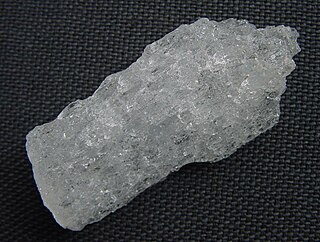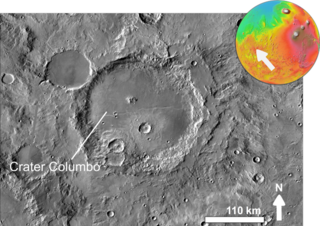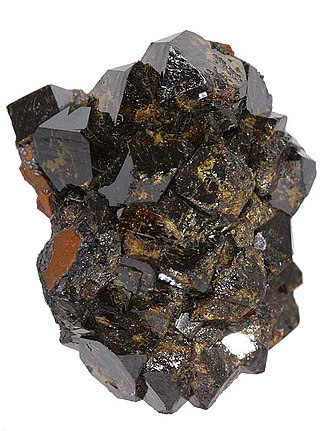
Alunite is a hydroxylated aluminium potassium sulfate mineral, formula KAl3(SO4)2(OH)6. It was first observed in the 15th century at Tolfa, near Rome, where it was mined for the manufacture of alum. First called aluminilite by J.C. Delamétherie in 1797, this name was contracted by François Beudant three decades later to alunite.

Kalinite is a mineral composed of hydrated potassium aluminium sulfate. It is a fibrous monoclinic alum, distinct from isometric potassium alum, named in 1868. Its name comes from kalium (derived from Arabic: القَلْيَه al-qalyah "plant ashes", which is the Latin name for potassium, hence its chemical symbol, "K".

Arthurite is a mineral composed of divalent copper and iron ions in combination with trivalent arsenate, phosphate and sulfate ions with hydrogen and oxygen. Initially discovered by Sir Arthur Russell in 1954 at Hingston Down Consols mine in Calstock, Cornwall, England, arthurite is formed as a resultant mineral in the oxidation region of some copper deposits by the variation of enargite or arsenopyrite. The chemical formula of Arthurite is CuFe23+(AsO4,PO4,SO4)2(O,OH)2·4H2O.

Columbus is a crater in the Terra Sirenum of Mars. It is 119 km in diameter and was named after Christopher Columbus, Italian explorer (1451–1506). The discovery of sulfates and clay minerals in sediments within Columbus crater are strong evidence that a lake once existed in the crater. Research with an orbiting near-infrared spectrometer, which reveals the types of minerals present based on the wavelengths of light they absorb, found evidence of layers of both clay and sulfates in Columbus crater. This is exactly what would appear if a large lake had slowly evaporated. Moreover, because some layers contained gypsum, a sulfate which forms in relatively fresh water, life could have formed in the crater.

Ashburtonite is a rare lead copper silicate-bicarbonate mineral with formula: HPb4Cu2+4Si4O12(HCO3)4(OH)4Cl.

Bílinite (Fe2+Fe23+(SO4)·22H2O) is an iron sulfate mineral. It is a product of the oxidation of pyrite in water. It is an acidic mineral that has a pH of less than 3 and is harmful to the environment when it comes from acid rock drainage (Keith et al., 2001).

Woodhouseite belongs to the beudantite group AB3(XO4)(SO4)(OH)6 where A = Ba, Ca, Pb or Sr, B = Al or Fe and X = S, As or P. Minerals in this group are isostructural with each other and also with minerals in the crandallite and alunite groups. They crystallise in the rhombohedral system with space group R3m and crystals are usually either tabular {0001} or pseudo-cubic to pseudo-cuboctahedral. Woodhouseite was named after Professor Charles Douglas Woodhouse (1888–1975), an American mineralogist and mineral collector from the University of California, Santa Barbara, US, and one-time General Manager of Champion Sillimanite, Inc.

Meridianiite is the mineral consisting of magnesium sulfate undecahydrate, MgSO
4·11H
2O. It is colorless transparent crystalline salt that precipitates from solutions saturated in Mg2+ and SO42− ions at temperatures less than 2 °C. The synthetic compound was formerly known as Fritzsche's salt.
The mineralogy of Mars is the chemical composition of rocks and soil that encompass the surface of Mars. Various orbital crafts have used spectroscopic methods to identify the signature of some minerals. The planetary landers performed concrete chemical analysis of the soil in rocks to further identify and confirm the presence of other minerals. The only samples of Martian rocks that are on Earth are in the form of meteorites. The elemental and atmospheric composition along with planetary conditions is essential in knowing what minerals can be formed from these base parts.

Beudandite is a secondary mineral occurring in the oxidized zones of polymetallic deposits. It is a lead, iron, arsenate, sulfate with endmember formula: PbFe3(OH)6SO4AsO4.

Tsumebite is a rare phosphate mineral named in 1912 after the locality where it was first found, the Tsumeb mine in Namibia, well known to mineral collectors for the wide range of minerals found there. Tsumebite is a compound phosphate and sulfate of lead and copper, with hydroxyl, formula Pb2Cu(PO4)(SO4)(OH). There is a similar mineral called arsentsumebite, where the phosphate group PO4 is replaced by the arsenate group AsO4, giving the formula Pb2Cu(AsO4)(SO4)(OH). Both minerals are members of the brackebuschite group.

Walfordite is a very rare tellurite mineral that was discovered in Chile in 1999. The mineral is described as orange with orange-yellow streak, and is determined to have a chemical formula of Fe3+,Te6+Te4+3O8 with minor titanium and magnesium substitution resulting in an approximate empirical formula of (Fe3+,Te6+,Ti4+,Mg)(Te4+)3O8.
This list gives an overview of the classification of non-silicate minerals and includes mostly International Mineralogical Association (IMA) recognized minerals and its groupings. This list complements the List of minerals recognized by the International Mineralogical Association series of articles and List of minerals. Rocks, ores, mineral mixtures, not IMA approved minerals, not named minerals are mostly excluded. Mostly major groups only, or groupings used by New Dana Classification and Mindat.
Carlosruizite is a sulfate or selenate–iodate mineral with chemical formula: K6(Na,K)4Na6Mg10(SeO4)12(IO3)12·12H2O. It has a low density (specific gravity of 3.36), colorless to pale yellow, transparent mineral which crystallizes in the trigonal crystal system. It forms a series with fuenzalidaite.

Hidalgoite, PbAl3(AsO4)(SO4)(OH)4, is a rare member of the beudantite group and is usually classified as part of the alunite family. It was named after the place where it was first discovered, the Zimapán mining district, Hidalgo, Mexico. At Hidalgo where it was initially discovered, it was found as dense white masses in alternating dikes of quartz latite and quartz monzonite alongside other secondary minerals such as sphalerite, arsenopyrite, cerussite and trace amounts of angelsite and alamosite, it was then rediscovered at other locations such as Australia where it occurs on oxidized shear zones above greywacke shales especially on the anticline prospects of the area, and on fine grained quartz-spessartine rocks in Broken Hill, Australia. Hidalgoite specimens are usually associated with copper minerals, clay minerals, iron oxides and polymetallic sulfides in occurrence.
Florencite-(Sm) is a very rare mineral of the plumbogummite group (alunite supergroup) with simplified formula SmAl3(PO4)2(OH)6. Samarium in florencite-(Sm) is substituted by other rare earth elements, mostly neodymium. It does not form separate crystals, but is found as zones in florencite-(Ce), which is cerium-dominant member of the plumbogummite group. Florencite-(Sm) is also a samarium-analogue of florencite-(La) (lanthanum-dominant) and waylandite (bismuth-dominant), both being aluminium-rich minerals.

Segnitite is a lead iron(III) arsenate mineral. Segnitite was first found in the Broken Hill ore deposit in Broken Hill, New South Wales, Australia. In 1991, segnitite was approved as a new mineral. Segnitite has since been found worldwide near similar locality types where rocks are rich in zinc and lead especially. it was named for Australian mineralogist, gemologist and petrologist Edgar Ralph Segnit. The mineral was named after E. R. Segnit due to his contributions to Australian mineralogy.
Gallium(III) sulfate refers to the chemical compound, a salt, with the formula Ga2(SO4)3, or its hydrates Ga2(SO4)3·xH2O. Gallium metal dissolves in sulfuric acid to form solutions containing [Ga(OH2)6]3+ and SO42− ions. The octadecahydrate Ga2(SO4)3·18H2O crystallises from these solutions at room temperature. This hydrate loses water in stages when heated, forming the anhydrate Ga2(SO4)3 above 150 °C and completely above 310 °C. Anhydrous Ga2(SO4)3 is isostructural with iron(III) sulfate, crystallizing in the rhombohedral space group R3.
Gallobeudantite is a secondary, Gallium-bearing mineral of beudantite, where the Iron is replaced with Gallium, a rare-earth metal. It was first described as a distinct mineral by Jambor et al in 1996. Specific Gallium minerals are generally rare and Gallium itself is usually obtained as a by-product during the processing of the ores of other metals. In particular, the main source material for Gallium is bauxite, a key ore of aluminium. However, Gallobeudantite is too rare to be of economic value. Its main interest is academic and also among mineral collectors.















